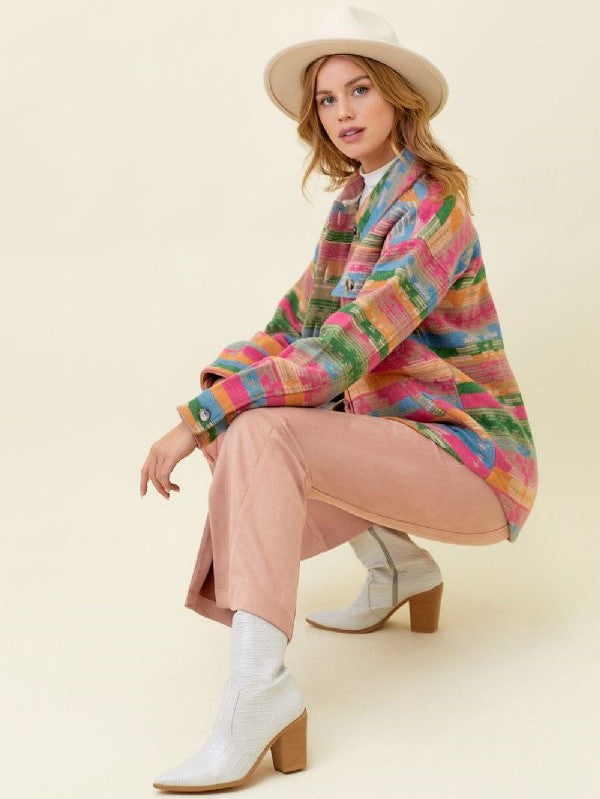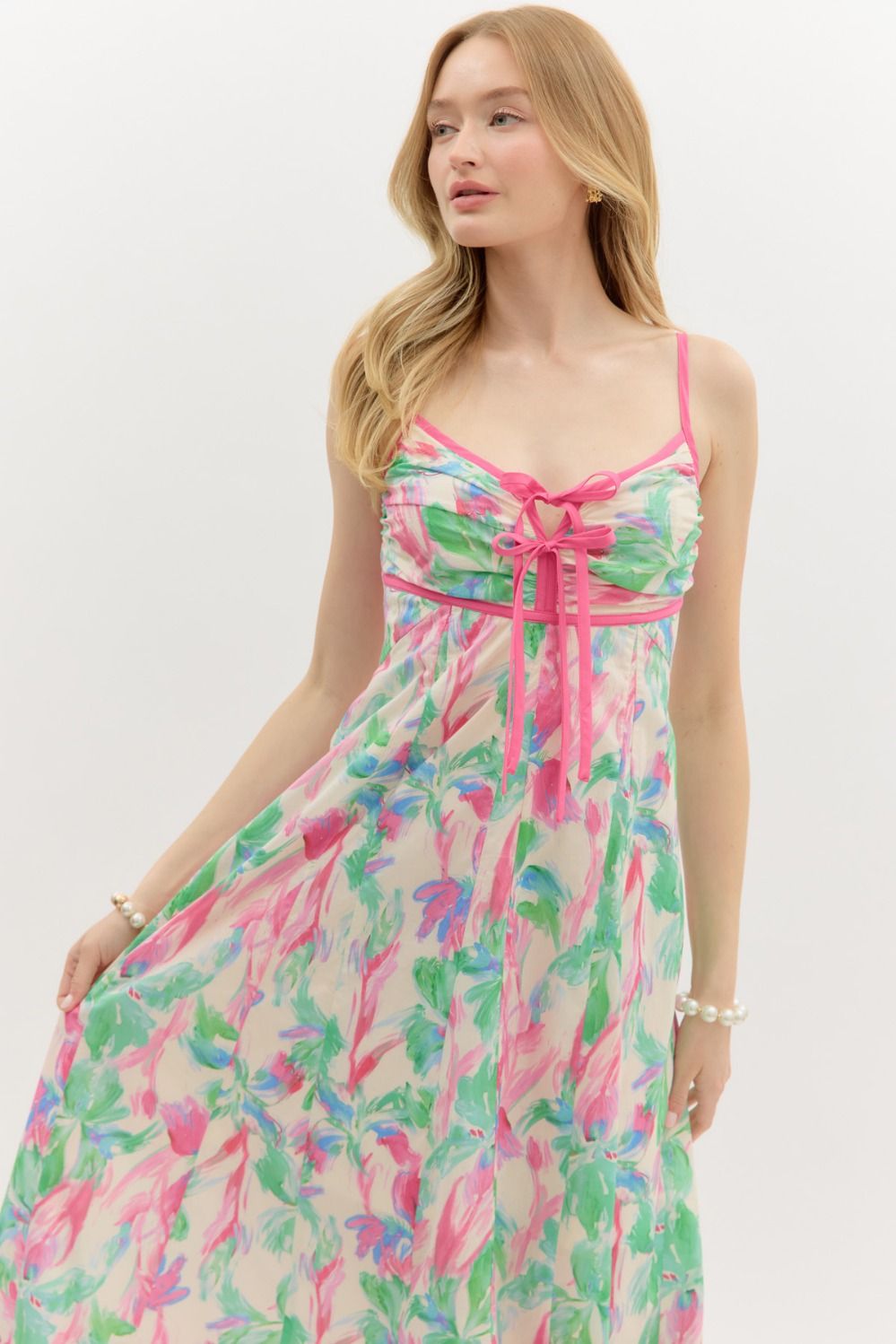Finding clothes that fit beautifully isn't about conforming to arbitrary rules or hiding parts of yourself – it's about understanding how different silhouettes interact with your unique proportions to create harmonious, confident looks. The science behind flattering fits combines geometry, proportion theory, and visual perception to help you choose pieces that make you feel amazing while looking polished and put-together. This knowledge empowers you to shop with confidence and build a wardrobe that truly serves your lifestyle and aesthetic goals.
Understanding Body Geometry and Proportion
Proportional Balance is the foundation of flattering fit. Rather than focusing on specific measurements, think about the relationships between different areas of your body and how clothing can create visual harmony. The Empire Floral Bow Tie Midi Dress demonstrates how strategic placement of design elements can create beautiful proportional balance by defining the narrowest part of the torso.
Visual Weight Distribution affects how an outfit reads overall. Different silhouettes distribute visual weight differently, and understanding this helps you choose pieces that create the proportions you find most flattering and confidence-inspiring.
Line and Flow determine how the eye moves across your silhouette. Vertical lines tend to elongate, horizontal lines can broaden, and curved lines create softness. The Balloon Half Sleeve Poplin Midi Dress W/Pockets uses strategic shaping to create flowing lines that feel both structured and feminine.
The Psychology of Fit Confidence
When clothes fit well, you naturally carry yourself differently. Good fit creates a feedback loop of confidence – you feel better, you stand taller, and you project more self-assurance. This psychological component is just as important as the visual aspects of flattering fit.
Comfort and Movement: Truly flattering clothes allow natural, confident movement. If you're constantly adjusting or feeling restricted, even the most visually appealing silhouette won't serve you well. The Luba Tencel Utility Romper likely demonstrates this principle by combining structure with comfortable, moveable construction.
Personal Style Alignment: Flattering fit isn't just about following rules – it's about finding silhouettes that align with your personal aesthetic and make you feel authentically yourself.
Silhouette Categories and Their Effects
A-Line Silhouettes create graceful, universally flattering shapes by fitted through the bodice and flowing outward. The Floral Tiered Maxi Dress W/Drawstring Waist exemplifies this silhouette's ability to create elegant proportions while offering comfort and movement.
Fit-and-Flare Styles combine fitted bodices with flowing skirts, creating defined waistlines and balanced proportions. These silhouettes work beautifully for both casual and dressy occasions while offering feminine, flattering lines.
Straight Silhouettes create clean, modern lines that work particularly well for professional settings. The Zip Front Drawstring Waist Mini Dress demonstrates how straight silhouettes can be both structured and comfortable.
Wrap Styles naturally adjust to different body proportions while creating universally flattering V-necklines and defined waistlines. These silhouettes are incredibly versatile and confidence-inspiring.
Understanding Necklines and Their Impact
V-Necklines create vertical lines that tend to elongate the torso and neck while drawing attention upward. The Puff Sleeve V-Neck Woven Top shows how V-necklines can create elegant, sophisticated looks while remaining versatile and wearable.
Scoop Necklines offer soft, feminine curves that work beautifully for casual and dressy occasions. They're generally flattering and approachable while maintaining sophistication.
Square Necklines create structured, architectural interest while offering good coverage. The Ruffled Sleeve Smocked Tiered Dress W/Square Neck demonstrates how square necklines can feel both modern and romantic.
High Necklines create sophisticated, covered looks that work beautifully for professional settings and cooler weather. They can make statements while remaining elegant and appropriate.
Sleeve Styles and Proportion
Fitted Sleeves create sleek, polished looks that work well for professional settings and when you want clean, uninterrupted lines. They're versatile and generally flattering for most arm shapes.
Flowing Sleeves add feminine movement and visual interest while providing comfortable coverage. The Flutter Sleeve Pintuck Dress W/Elastic Waist shows how flowing sleeves can add romantic detail without overwhelming the overall silhouette.
Statement Sleeves like puff or bell styles create focal points and add personality to outfits. When wearing statement sleeves, balance them with simpler elements elsewhere in your outfit.
Sleeveless Styles create clean, modern looks that work beautifully for layering and warm weather. They offer versatility and can be dressed up or down easily.
Waistline Placement and Its Effects
Natural Waist placement creates classic, balanced proportions by defining your narrowest point. This traditional approach works well for most body types and creates timeless, elegant silhouettes.
Empire Waist sits just below the bust, creating flowing, comfortable silhouettes that work beautifully for casual wear and when you want ease of movement. The Empire Floral Bow Tie Midi Dress demonstrates this technique's graceful effects.
Drop Waist creates relaxed, modern silhouettes that feel current and comfortable. These styles work well for casual occasions and when you prefer looser, more relaxed fits.
No Defined Waist creates straight, architectural silhouettes that feel modern and sophisticated. These styles work particularly well for professional settings and minimalist aesthetics.
Length Considerations and Visual Impact
Mini Lengths create youthful, energetic looks that work beautifully for casual occasions and when you want to show off great shoes. The Bubble Hem Mini Dress W/Shirring demonstrates how mini lengths can be both playful and sophisticated.
Midi Lengths offer versatile, sophisticated options that work for both professional and casual settings. They're incredibly flattering for most heights and body types while offering appropriate coverage.
Maxi Lengths create elegant, dramatic silhouettes that work beautifully for special occasions and when you want to make sophisticated statements. The Garden Reverie Maxi Dress likely showcases this length's romantic, flowing appeal.
Asymmetrical Lengths add modern, interesting details while creating movement and visual interest. These styles feel current and can add personality to your wardrobe.
Fit Adjustments and Tailoring Considerations
Strategic Tailoring can transform good pieces into great ones. Understanding which adjustments make the biggest impact helps you invest your alteration budget wisely.
Hemming is often the most cost-effective alteration and can dramatically improve how a piece looks and feels on your body. Proper hem length can make or break a silhouette's overall success.
Waist Adjustments can improve fit significantly, but consider whether the cost and effort are worth it compared to finding pieces that fit well initially.
Shoulder Fit is crucial and difficult to alter, so prioritize finding pieces that fit well through the shoulders from the start.
Fabric Choice and Fit Relationship
Structured Fabrics hold their shape and create architectural silhouettes. They work well when you want defined lines and professional appearances.
Flowing Fabrics drape naturally and create soft, feminine silhouettes. The Smocked Waist Double Ruffle Sleeve Print Dress likely uses flowing fabrics to create graceful movement and comfortable fit.
Stretch Fabrics offer comfort and ease of movement while maintaining shape. They're excellent for active lifestyles and when you need pieces that adapt to your body throughout the day.
Non-Stretch Fabrics create structured, architectural looks but require more precise fitting. They work beautifully for professional settings and special occasions.
Seasonal Fit Considerations
Summer Fits should prioritize breathability and comfort while maintaining style. Looser fits and natural fabrics work well for hot weather while still looking polished.
Winter Fits need to accommodate layering while maintaining attractive silhouettes. Consider how pieces will look and fit with various layering options.
Transitional Fits should work across changing temperatures and varying styling needs. Versatile pieces that adapt to different seasonal styling approaches offer excellent value.
Professional Fit Standards
Conservative Professions typically require more structured, defined fits that convey competence and authority. Focus on pieces that maintain their shape and create polished appearances.
Creative Professions often allow more experimental fits and silhouettes while still requiring professional appropriateness. Balance creativity with workplace expectations.
Client-Facing Roles need fits that inspire confidence and trust while remaining comfortable for long days and varied activities.
Building Fit Confidence
Start with Basics: Build your understanding with classic, well-fitting basics before experimenting with more unusual silhouettes.
Trust Your Instincts: If something doesn't feel right, it probably isn't the right fit for you, regardless of how it looks on others or in photos.
Invest in Key Pieces: Quality construction and proper fit in key wardrobe pieces creates a foundation for confident dressing.
Experiment Gradually: Try new silhouettes and fits gradually rather than overhauling your entire wardrobe at once.
Common Fit Mistakes to Avoid
Size Fixation: Don't get attached to specific sizes across different brands. Focus on how pieces actually fit rather than the number on the label.
Trend Over Fit: Choosing trendy pieces that don't fit well over classic pieces that do will never serve your confidence or style goals.
Ignoring Comfort: Beautiful fit should include comfort and ease of movement. Sacrificing comfort for appearance rarely results in confident, authentic style.
One-Size-Fits-All Thinking: Different occasions, seasons, and personal moods may call for different types of fits. Build variety into your wardrobe rather than sticking to one silhouette.
Understanding flattering fit is about creating harmony between your body, your clothes, and your confidence. It's not about following rigid rules or hiding anything – it's about choosing silhouettes that make you feel amazing and look polished. The science behind fit gives you tools for making informed decisions, but your personal preferences and comfort should always guide your final choices.
Remember, the most flattering fit is one that makes you feel confident, comfortable, and authentically yourself. Use these principles as guidelines, but trust your instincts and prioritize how clothes make you feel. When you find silhouettes that work well for your body and lifestyle, invest in quality pieces in those styles to build a wardrobe that truly serves your daily life and style goals.





